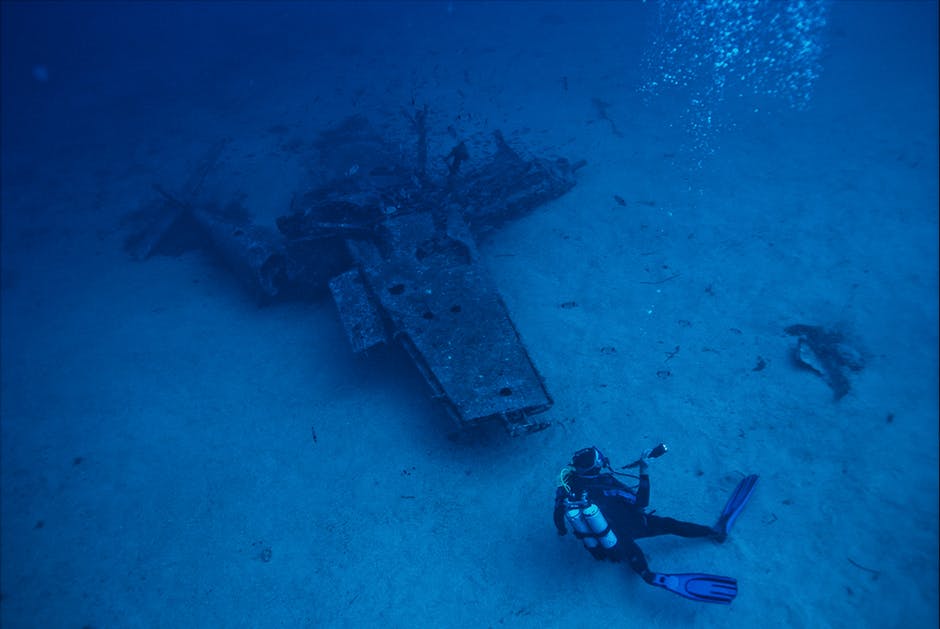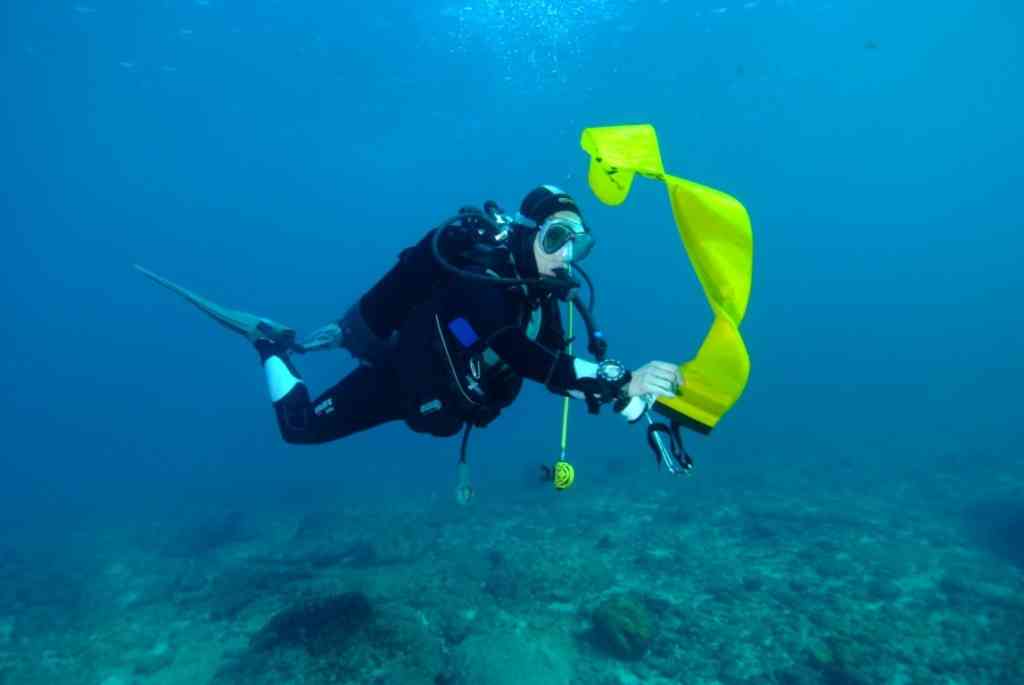The decompression decompression procedure training is intended for two types of divers: the recreational diver who has no notion of decompression diving and who holds the advanced nitrox course and who wishes to develop his knowledge and learn new techniques, and the diver aspiring to technical diving.
This training TDI covers the theory for planning and executing decompression dives, and especially the practice for controlling the proper management of air supply and stabilization for safe decompression diving.
The deco procedure training is organized in 2 to 3 days for people who already hold the Advanced Nitrox Training.
 The objective of this course is to train divers to plan and execute dives with decompression stops not exceeding 40 to 50 meters, unless the course is taught in combination with the course Extended Range (60 metres for extended range).
The objective of this course is to train divers to plan and execute dives with decompression stops not exceeding 40 to 50 meters, unless the course is taught in combination with the course Extended Range (60 metres for extended range).
The theoretical portion covers the following topics:
 Safety bearing vs. decompression stops
Safety bearing vs. decompression stops
 Physical
Physical
 Pressure
Pressure
 Physiology
Physiology
 Bubble forming mechanism
Bubble forming mechanism
 Advantages of hyperoxic mixtures for decompression
Advantages of hyperoxic mixtures for decompression
 Nitrogen absorption and removal
Nitrogen absorption and removal
 Carbon dioxide toxicity
Carbon dioxide toxicity
 Ascent / descent speed
Ascent / descent speed
 Hyperthermia
Hyperthermia
 Hypothermia
Hypothermia
 Psychological aspects (stress, panic, equipment, task management, time management)
Psychological aspects (stress, panic, equipment, task management, time management)
 Oxygen toxicity
Oxygen toxicity
 Nitrogen narcosis
Nitrogen narcosis
 Carbon monoxide toxicity
Carbon monoxide toxicity
 Choice of mixtures for decompression
Choice of mixtures for decompression
 Air
Air
 Enriched air
Enriched air
 Oxygen
Oxygen
 Equipment
Equipment
 Single or twin cylinder and choice of valves
Single or twin cylinder and choice of valves
 Choice of decompression cylinders
Choice of decompression cylinders
 Choice of regulators
Choice of regulators
 Harness vs. compensatory vest
Harness vs. compensatory vest
 Computer, depth gauge, stopwatch...
Computer, depth gauge, stopwatch...
 Reels and spools
Reels and spools
 Lifting bag/surface marker for drifting or decompression in open water
Lifting bag/surface marker for drifting or decompression in open water
 Jon-Line
Jon-Line
 Ballast and buoyancy during the dive and during decompression.
Ballast and buoyancy during the dive and during decompression.
 Diving tables vs. computers
Diving tables vs. computers
 Review of some models (Buhlmann, US Navy, ...)
Review of some models (Buhlmann, US Navy, ...)
 Proper use of computers for multi-level and decompression diving (mixing, O2)
Proper use of computers for multi-level and decompression diving (mixing, O2)
 Dive Planning
Dive Planning
 Standard planning (gas volume, oxygen limitations, nitrogen limitations, third party rule, SAC, RMV)
Standard planning (gas volume, oxygen limitations, nitrogen limitations, third party rule, SAC, RMV)
 Emergency planning (omission of decompression stops, decompression sickness, equipment failure)
Emergency planning (omission of decompression stops, decompression sickness, equipment failure)
 Procedures
Procedures
 Main mixture and decompression mixtures
Main mixture and decompression mixtures
 Downhill (input method, with reference, without reference, equipment)
Downhill (input method, with reference, without reference, equipment)
 Rise (variable speeds, position and trim)
Rise (variable speeds, position and trim)
 Drift or stationary decompression (lift line, reel and reel and lifting bag/surface marker, decompression cylinder vs. boat supplied)
Drift or stationary decompression (lift line, reel and reel and lifting bag/surface marker, decompression cylinder vs. boat supplied)
 Support (shoreline, down line, platform, boat)
Support (shoreline, down line, platform, boat)
The practical part of the decoration and procedure training covers the following topics:
 Pre-diving procedures
Pre-diving procedures
 Review of previous course skills (Advanced Nitrox-TDI)
Review of previous course skills (Advanced Nitrox-TDI)
 Selection and preparation of equipment adapted to a virtual ceiling environment
Selection and preparation of equipment adapted to a virtual ceiling environment
 Practice team exercises (deployment of the lifting bag, change of mix)
Practice team exercises (deployment of the lifting bag, change of mix)
 Harmonization of mixtures within the team
Harmonization of mixtures within the team
 Demonstrate basic ability with communication signals
Demonstrate basic ability with communication signals
 Demonstrate proper pre-dive planning (personal and team consumption limits, dive plan and decompression schedule).
Demonstrate proper pre-dive planning (personal and team consumption limits, dive plan and decompression schedule).
 Stress factor analysis and mitigation
Stress factor analysis and mitigation
 START (S-drill, Team, Air, Road, Tables)
START (S-drill, Team, Air, Road, Tables)
 Immersion maneuvering
Immersion maneuvering
 Demonstrate buoyancy control (ability to be stable in the water without the use of hands and flippers)
Demonstrate buoyancy control (ability to be stable in the water without the use of hands and flippers)
 Demonstrate a good awareness of their environment, their partner and other team members
Demonstrate a good awareness of their environment, their partner and other team members
 Demonstrate ease of surface and underwater swimming with a decompression cylinder
Demonstrate ease of surface and underwater swimming with a decompression cylinder
 Demonstrate the ability to remove and reattach the pressure relief cylinder while maintaining buoyancy control.
Demonstrate the ability to remove and reattach the pressure relief cylinder while maintaining buoyancy control.
 Ability to deploy a lifting bag solo and in a team
Ability to deploy a lifting bag solo and in a team
 Lift with decompression stops on emergency line/lift bag
Lift with decompression stops on emergency line/lift bag
 Remove and put on your mask
Remove and put on your mask
 Deploying the spare mask
Deploying the spare mask
 Appropriate reactions to gas leaks
Appropriate reactions to gas leaks
 Respond appropriately to a malfunction of the "direct system" (manual inflation)
Respond appropriately to a malfunction of the "direct system" (manual inflation)
 Ability to confirm changes in immersion mixes with partner and team members
Ability to confirm changes in immersion mixes with partner and team members
 Sharing a decompression cylinder for at least one minute
Sharing a decompression cylinder for at least one minute
 Appropriate and controlled reaction to a continuous flow decompression valve
Appropriate and controlled reaction to a continuous flow decompression valve
 Appropriate modification of the decompression schedule (time and depth)
Appropriate modification of the decompression schedule (time and depth)
 Towing of the tired diver on the surface and in immersion
Towing of the tired diver on the surface and in immersion
 Swimming in immersion while holding your breath
Swimming in immersion while holding your breath
 Execution of the dive plan according to the determined parameters (equipment, ascent and descent, decompression stops, proper monitoring of control instruments)
Execution of the dive plan according to the determined parameters (equipment, ascent and descent, decompression stops, proper monitoring of control instruments)
 Sharing an immersed air source
Sharing an immersed air source
 Deployment of the emergency regulator in immersion (air failure in static and moving)
Deployment of the emergency regulator in immersion (air failure in static and moving)
 Make a 3-minute safety stop for any dive that does not require a decompression stop
Make a 3-minute safety stop for any dive that does not require a decompression stop
 Demonstrate proper management and deployment of gas mixtures (bottom, deco, travel) including conservative management, depth and buoyancy control and environmental awareness
Demonstrate proper management and deployment of gas mixtures (bottom, deco, travel) including conservative management, depth and buoyancy control and environmental awareness
 Contingency situations according to the instructor (missed stop, extended bottom time, loss of line, loss of gas, loss of the lifting bag, poisoned diver, use of the Jon-line ...)
Contingency situations according to the instructor (missed stop, extended bottom time, loss of line, loss of gas, loss of the lifting bag, poisoned diver, use of the Jon-line ...)

